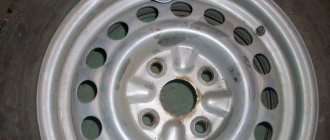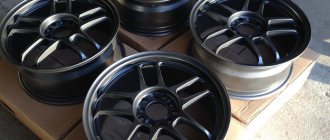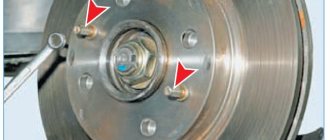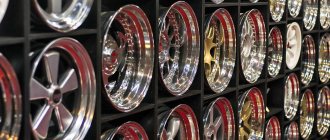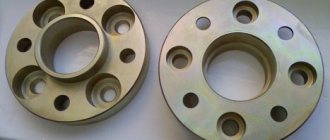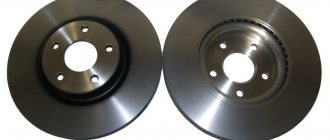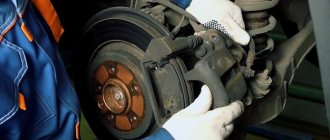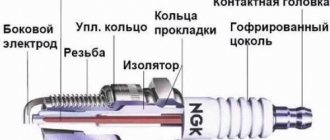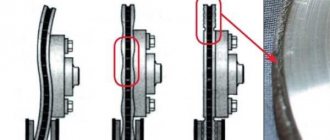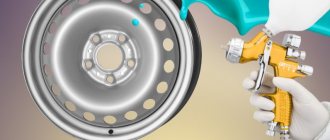The question is how to tell if a wheel is forged or cast, worries many car owners who are planning to purchase wheels produced using forging technology. Indeed: the price of the latter is quite high, so no one wants to become a victim of scammers. It is no coincidence that forged wheels are called the prerogative of wealthy car owners: their production technology is quite complex and energy-consuming, so they are manufactured abroad for Premium class vehicles. However, in our country the situation is somewhat different, which allows us to determine the price of these products several times lower! So, if you are wondering about What is the difference between forged wheels and cast wheels? And Which wheels are lighter: forged or cast?, this article is for you!
How are car wheel castings made?
In the production of forged wheels, aluminum alloy is used, which accounts for up to 97% of the total weight. To obtain the workpiece, the metal is initially melted on automated machines at temperatures up to 700 degrees and filled with argon gas. This process is needed to remove hydrogen and make the material wear-resistant. Titanium and magnesium are then added to the molten aluminum to improve strength. The prepared mixture is transferred to a special matrix to form a workpiece in the form of metal pillars.
The assembly process uses pressing machines that operate on the anvil principle. The aluminum pillars formed during the first stage of processing are cut into pieces. One blank then forms a forged disk. To give the model its shape, the blanks are fed into an oven with a heating temperature of up to 500 degrees. Processing makes the metal soft and pliable.
After repeated processing in the oven, the workpiece is transferred to a press, which forms the first outlines. The prepared product is moved to pottery equipment, where hamps, edges, and stiffeners are formed. A program-controlled milling machine helps make spokes on a forged wheel and determine technological holes.
The last step that manufacturers do involves polishing and painting. All work is automated, so defects and inaccurate application of paint are eliminated. The disc is then checked for flaws, undergoes quality control, and packaged for transportation. Inspection helps to immediately identify a defective batch.
Cheap and beautiful
If you discard all thoughts about purchasing simple stamped disks, then it is best to opt for cast components, which can be found in almost any auto store.
Cast parts are produced using a fairly complex technology, which, however, does not mean they are expensive. Casting production includes several stages. The first of them is the preparation of a special alloy.
As a rule, such components are based on an alloy of magnesium and aluminum. This composition is relatively light in weight, but at the same time has sufficient strength and resistance to increased loads.
After preparing the alloy, the casting process itself begins, the red-hot composition is poured into a specially prepared mold and cools. During this time, the cast disc hardens, becomes stronger and is visually similar to the final product that can be seen on store shelves.
Before painting, the cast disc undergoes a hardening procedure, which is carried out using the artificial aging method. This allows you to remove the increased load on the internal space of the part and, thereby, increase its strength.
Popular tire models
- Yandex.Market rating: Yandex.Market: 4.5
Goodyear Eagle Sport TiresSeasonality: summer Spikes: no Diameter: 14 / 15 / 16
- Yandex.Market rating: Yandex.Market: 4.5
Goodyear EfficientGrip Performance Tires
Seasonality: summer Spikes: no Diameter: 15 / 16 / 17 / 18 / 19 / 20
- Yandex.Market rating: Yandex.Market: 4.5
Goodyear Eagle Sport TZ tires
Seasonality: summer Spikes: no Diameter: 16 / 17 / 18
- Yandex.Market rating: Yandex.Market: 5
Goodyear EfficientGrip Performance 2 Tires
Seasonality: summer Spikes: no Diameter: 15 / 16 / 17 / 18 / 19 / 20
- Yandex.Market rating: Yandex.Market: 4
Goodyear EfficientGrip 2 SUV Tires
Seasonality: summer Spikes: no Diameter: 16 / 17 / 18 / 19 / 20
- Yandex.Market rating: Yandex.Market: 4.5
Goodyear Wrangler All-Terrain Adventure tires with Kevlar
Seasonality: summer Spikes: no Diameter: 15 / 16 / 17 / 18 / 19 / 20
- Yandex.Market rating: Yandex.Market: 4.5
Goodyear Eagle Sport SUV TZ tires
Seasonality: summer Spikes: no Diameter: 17 / 18
- Yandex.Market rating: Yandex.Market: 4
Goodyear Wrangler HP All Weather Tires
Seasonality: summer Spikes: no Diameter: 15 / 16 / 17 / 18 / 19
- Yandex.Market rating: Yandex.Market: 4.5
Goodyear EfficientGrip SUV Tires
Seasonality: summer Spikes: no Diameter: 16 / 17 / 18 / 19 / 20 / 21 / 22
- Yandex.Market rating: Yandex.Market: 4.5
Tires Goodyear Eagle F1 Asymmetric 5
Seasonality: summer Spikes: no Diameter: 17 / 18 / 19 / 20 / 21 / 22
- Yandex.Market rating: Yandex.Market: 4
Goodyear Vector 4Seasons Gen-3 tires
Seasonality: all-season Spikes: no Diameter: 15 / 16 / 17 / 18 / 19
- Yandex.Market rating: Yandex.Market: 5
Goodyear Eagle F1 SuperSport Tires
Seasonality: summer Spikes: no Diameter: 18 / 19 / 20 / 21
- Yandex.Market rating: Yandex.Market: 4.5
Goodyear Eagle F1 Asymmetric 3 SUV tires
Seasonality: summer Spikes: no Diameter: 17 / 18 / 19 / 20 / 21 / 22
- Yandex.Market rating: Yandex.Market: 4.5
Goodyear Eagle F1 SuperSport R tires
Seasonality: summer Spikes: no Diameter: 19 / 20 / 21
- Goodyear Eagle F1 SuperSport RS Tires
Seasonality: summer Spikes: no Diameter: 21
Video on the topic
Related publications
- Which is better, timing belt or chain?
- MacPherson suspension: what is it?
- Wankel engine: what it is and how it works
- Shift Lock Release: what is this button for on an automatic transmission?
Leave a review
Cancel reply
Which is better: cast or forged
To answer this question, you need to consider the features of the models, determine their advantages and disadvantages. Since it is easy for a specialist to see the difference between the assembled specimens, we will tell you in more detail how to distinguish forged car wheels from cast ones. The first difference you need to pay attention to is the type of marking. Production light alloy models are marked on the inside with clearly defined symbols. Forging is stamped using a different technology - here the symbols are pressed in from the outside and have a characteristic recess.
There are an additional number of signs that will help with identification and selection. Forging differs from cast wheels:
- Assembly technology. A forged model can be identified by its filling - here the shelf and spokes are often assembled together with bolts, while cast products are cast from one mold. Forging requires several steps, which makes these wheels more expensive.
- Build quality, wear resistance of the material. Forged models are more durable. They can withstand severe loads, do not deform during side impacts, and are repairable even with severe damage.
- Weight. A forged car wheel is heavier. This must be taken into account when purchasing. If you are making your car lighter, it is better to choose light-alloy models. This is the best option because it reduces weight by up to 20% when comparing the same wheel size.
Despite the superiority of forging, you should not choose it without evaluating all the parameters. It has different sides at the same time, which should be distinguished and taken into account depending on the driving style and class of the car. Before purchasing, you need to additionally determine your budget, since forging is much more expensive than light-alloy kits.
The difference is in the production technology!
The production technology of cast and forged wheels determined the name of their types. For the manufacture of both the first and second, aluminum alloys with alloying additives are used. The difference lies precisely in the technology, which involves the use of hot die forging, hardening and artificial aging for cast wheels. All these processes allow us to achieve a material structure that will withstand loads well due to its strength and ductility! Thanks to it, forged wheels can be repaired even in situations where cast wheels cannot be restored. Even with strong impacts leading to deformation, forged wheels are not destroyed.
Advantages and disadvantages
You can determine which kit suits your car based on their parameters. The cast construction is more widespread and is easy to find and maintain. But it is inferior in strength to expensive forged models.
Let's look at the advantages of forged car wheels:
- Structural strength. Cast specimens deform much faster than competitors and wear out even with careful use. Forging is the best solution for uneven roads, although it is more expensive. It should be chosen by motorists who often travel on bad roads. It withstands collisions with stones and changes in the canvas, unlike cast models.
- Durability. It is not difficult to determine which option is the best, since forged wheels have anti-corrosion properties. They do not require heavy maintenance.
- Vibration absorption. Installing forging allows you to avoid sound insulation and easily solves the problem of poor-quality sound insulation of a car. Unlike cast copies, forged wheels make the ride comfortable and silent. They handle bumps better.
- Aesthetics. Forged models are an expensive pleasure, which is often chosen by car enthusiasts with premium cars. The models are more expensive than competitors due to technical advantages and original appearance.
The rigidity of forging can be considered an advantage and a disadvantage. The strength of the structure distinguishes the model from alloy wheels. It allows you to overcome unevenness and not worry about the integrity of the rim or spokes. However, excessive wheel stiffness increases the load on the suspension. When hitting a bump, the entire impact is taken by the levers and struts. The disadvantage of the model is its heavy design, which impairs the acceleration of the car, and the price. Forging is more expensive than competitors made from cast alloys and requires expensive repairs if damaged.
Differences in rim and appearance
Another method for identifying forged wheels is to feel the rim. The rim thickness of the forged disc is 3 mm. Cast thickness – 6 mm. The difference is easy to feel. The spokes of a forged one are also narrower than those of a cast one. Due to this, the mass of the forged one is significantly (3-4 kg) less than that of the cast one.
If the disc has simple, unpretentious spokes, then it is most likely forged. Alloy wheels are more artistic and have more different openwork shapes. This is because casting is much easier to process on machines. The simple shape most likely belongs to a forged disc. Complex, with many spokes, maybe cast or forged.
Many domestic forged wheels are manufactured in former defense plants that were sold for next to nothing. Therefore, manufacturers have the opportunity to make wheels at a low price comparable to alloy wheels. Their quality is excellent, and their shape is simple, because the CNC machines are old-style.
If you want to know what forged wheels look like, look at the picture above. The first thing that catches your eye is that they are simple. Below are alloy wheels.
In modern factories, forged wheels are not inferior in design to cast ones. In addition, to reduce the cost of products, some factories also make cast ones of simple shape. So simplicity of form is an additional parameter, but not an absolute one.
Characteristic differences of light alloy cast wheels
As a rule, alloy wheels are made from aluminum alloys, less often - magnesium. They have many advantages.
- Beautiful. It is easy to give cast molds different configurations. In this case, the designers’ imagination is limited only by the designers’ requirements for the strength of the wheel. Forged wheels also look good, but their shape is more limited by technological capabilities. The fact is that in the technology of hot die forging, as the process of “forging” disks is correctly called, there are more restrictions associated with the permissible shapes of the dies and, accordingly, the resulting product. Cast forms can be more fanciful, and the choice of “casting” is incomparably richer.
Alloy wheels have a wide variety of design and external design options - Economical. In theory, alloy wheels actually reduce fuel consumption. On the one hand, lightweight wheels have a lower moment of inertia, which means they reduce energy costs when accelerating a car. But on the other hand, the most economical acceleration is smooth acceleration with minimal movement of the gas pedal. And with such acceleration, the inertia of the rotating parts fades into the background. At the same time, wheels with greater inertia increase the vehicle's range (the distance it can travel without pressing the gas or brake pedals), which means you have to press the gas pedal less often. That is, the main thing in saving fuel is the driving style: smooth acceleration and minimal braking. True, the weight of the car also affects fuel consumption, and with alloy wheels the whole car becomes a little lighter.
- Dynamic. The engines of modern cars are quite powerful, so that during a sharp start from a standstill the drive wheels will slip. Due to the lower rotational inertia, a light alloy wheel will begin to slip a little earlier. This will have an effect, but will not add acceleration to the car, rather the opposite, because there will no longer be traction on the slipping wheel. But on all-wheel drive vehicles, on vehicles with large wheels, this theory really works. The formula here is simple and known from a school physics course: the angular acceleration of a wheel is directly proportional to the torque supplied to it and inversely proportional to the moment of inertia.
- Comfortable. Large unsprung mass transmits shocks from road irregularities more strongly to the car body, reducing comfort in the cabin. A lighter wheel means more comfortable movement.
- Durable. Aluminum alloy is much more resistant to corrosion than sheet steel. That is why alloy wheels retain their original appearance longer, are more resistant to the aggressive environment of winter city streets, and do not require touch-up.
- Good for winter. The attractiveness of alloy wheels for winter conditions is due to the same corrosion resistance. The reagents used to treat city streets quickly corrode the enamel of steel stampings, after which the metal itself begins to rust. Aluminum wheels are coated with a layer of durable oxide film, and if the surface does not receive any mechanical damage, they retain an attractive appearance for a long time.
How to distinguish forged car wheels from steel ones
Not entirely honest sellers take advantage of the buyer’s ignorance of the characteristics and appearance of the discs, but a fake can be determined mainly by weight. The average weight of a steel disk should not exceed 4-5 kg with a diameter of 15 inches, but a forged one with the same diameter will already weigh 7-8 kg. The described difference will allow you to correctly determine the material of the disk.
The second difference is based on the fact that the edge of the forged part may be slightly uneven and rough. This happens because during the production process, the blanks of this part of the wheel are further processed on a lathe, while steel ones do not undergo this procedure, and, accordingly, their surface will be even and smooth. It is worth paying attention to the nature of the application of brand inscriptions. On steel parts they will be more voluminous, and on forged parts they will be extruded on the surface.
The main characteristics of forged rims are as follows:
- long service life;
- low weight;
- attractive appearance;
- does not “injure” the vehicle’s chassis;
- allows you to repair any damage.
Forged version
To determine the exact differences before purchasing, it is a good idea to study the specifics of the product.
Typically the labeling includes the following information:
- Rim width is the first number on the line indicating the distance between the inner parts of the rim in inches.
- Edge type - shows the shape of the edge of the rim, i.e. where the wheel and rim meet.
- Connectivity - indicated by the symbols “x” and “-”. The first of them means that the rim is one-piece, and the second shows that it can be easily assembled and disassembled.
- Mounting diameter - the size of the mounting rim for the tire.
- Annular protrusions or rolls are located on both sides of the metal part of the wheel and are used to block the outflow of air when there is external pressure on the cover. The additional function of these mounts is to secure the tire to the rim.
- Disc overhang is the interval between the point of contact of the structure with the hub and the center of the disc cross-section.
- The diameter of the mounting hole - the central hole, is usually indicated in millimeters. This factor for passenger cars ranges from 50 to 70 mm. It is necessary that the diameter exactly matches the seating belt of the car hub.
This is important during high-speed driving, a sudden stop, or when entering a sharp turn, because in a situation, for example, with a problem engine, you can always call a tow truck and get home by taxi, but in the case of a disk failure while driving you will have to deal with it immediately to avoid numerous traffic problems.
Modern range of wheels
Steel wheels have a centuries-old history, which were installed on all cars around the world. With the advent of die-cast models, no one was in a hurry to abandon the previous copies. Alloy wheels have their own advantages, which are expressed in attractiveness and higher reliability. But everything is ruined by the high cost. The last to be developed were forged models, which are in many ways superior to their counterparts. But again, high cost becomes a stumbling block. This range of products forces users to think about what will be best for their car, what the difference is and what choice will make the most sense.
Humanity has not yet managed to create ideal car wheels that could satisfy all the needs of car owners and surpass existing analogues in every parameter. Each user has to choose the most appropriate option, analyzing the pros and taking into account the cons.
Stamped discs
A stamped steel product is the most affordable option available. Aluminum products will cost at least twice as much. Stamped products run the risk of bending when a car passes through holes. This is where their advantage lies, because the main impact will be on the disc, and not on the body and suspension.
Stamped products weigh a lot, which creates an obstacle to rapid acceleration and good braking. Installing such an element on a car instantly increases the unsprung weight of the vehicle, which negatively affects the level of passenger comfort and the performance of the suspension. If you think about which wheels are best to choose for winter use, then this option is most suitable. After all, in winter no one is chasing dynamics.
Forging from Germany
One of the most interesting in design, and with the quality inherent in German products in general, are Hartge wheels. The company with the same name Herbert Hartge GmbH (named after the founder Herbert Hartge) was founded back in 1971 and at that time became the only service center on the southern border of Germany with France for BMW.
Later, the owner, who was passionate about racing and had thoroughly studied the internal structure of cars, decided to create a tuning studio as well. True, it came to discs only in 1993, when their first line was released. The wheels and much more that this workshop produced were most loved by Mercedes fans, and today Herbert Hartge GmbH is one of the official suppliers of this concern.
Beautiful and reliable Hartge wheels
No less popular and deservedly revered for its excellent quality and modern design is the AEZ brand of forged wheels. The brand was founded in the 90s and at first was known only in Germany. But after joining the largest company Alcar, which contributed to the growth of production, this brand became one of the largest “players” in the European wheel market.
AEZ Kaiman
AEZ Zeus
AEZ Crest
On Russian shelves you can also see wheels under the Proline Wheels, or PLW, logo. Their homeland is also Germany, the company is based in Mannheim. However, production is located in Asia, most likely in China - therefore the price tag for these discs is more adequate.
ProLine Wheels TX100
ProLine Wheels ZX100
ProLine PXF
The main differences between forging and casting
Don't let the external similarity of these different discs fool you. In fact, the difference between forged and cast wheels is significant. After studying our comparative analysis, you will quickly understand why premium cars are equipped with forging, you will be able to determine a forged and a cast wheel by their external characteristics, and you will no longer be tormented by the problem of choice.
There are many differences, you need to study each of them:
- For both options, compositions based on aluminum or magnesium are used. Each one is a big secret, but they are all similar to each other, at least in the basics.
- The weight of consumables created using different methods does not differ much. Alloy wheels are heavier, but not by much. This difference is due to the peculiarities of the production process. Since the weight of different types of wheel rims differs insignificantly, you don’t need to rely on this indicator.
- The shape and configuration is also not a fundamental difference. Thanks to the development of new metal processing techniques, manufacturers can implement different ideas and create original models with complex patterns.
- The method of applying inscriptions to wheels is radically different. On cast models there are raised inscriptions. Forging is distinguished by engraving and stamps.
- Alloy wheels often have irregularities on the edge, which can be seen upon careful and thorough examination. This cannot happen in forging, since all the parameters of these models are brought to the ideal.
- The high cost of forged wheels is explained by the complex production process and the need to use special, expensive equipment. In this case, the metal is processed using complex technology, which requires high labor costs.
Based on this information, you can already get a good idea of the range of wheels. It will not be difficult to distinguish forged wheels from cast ones and identify a fake.

